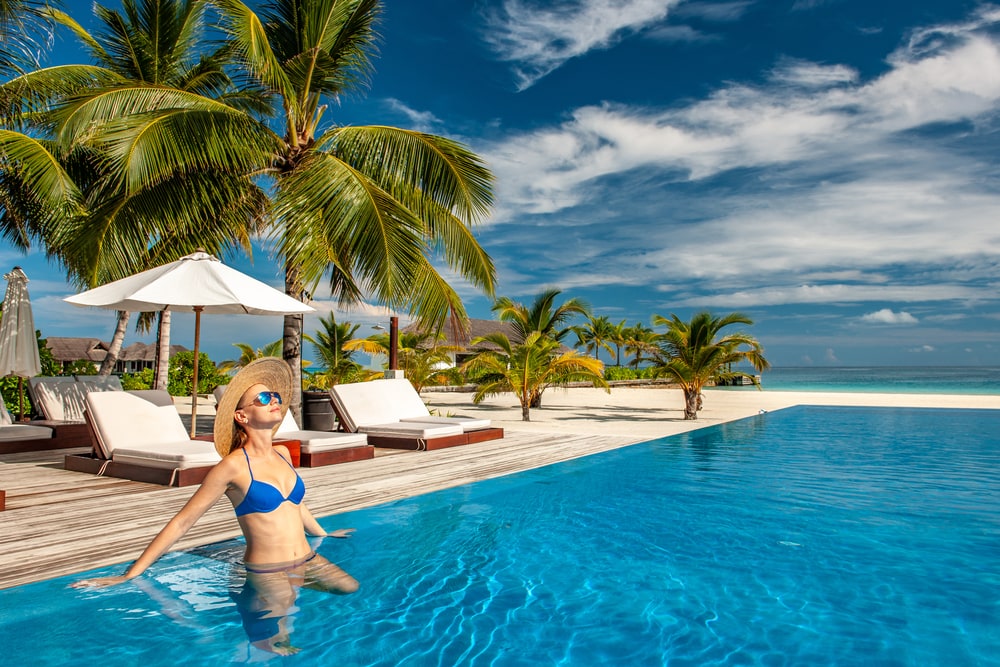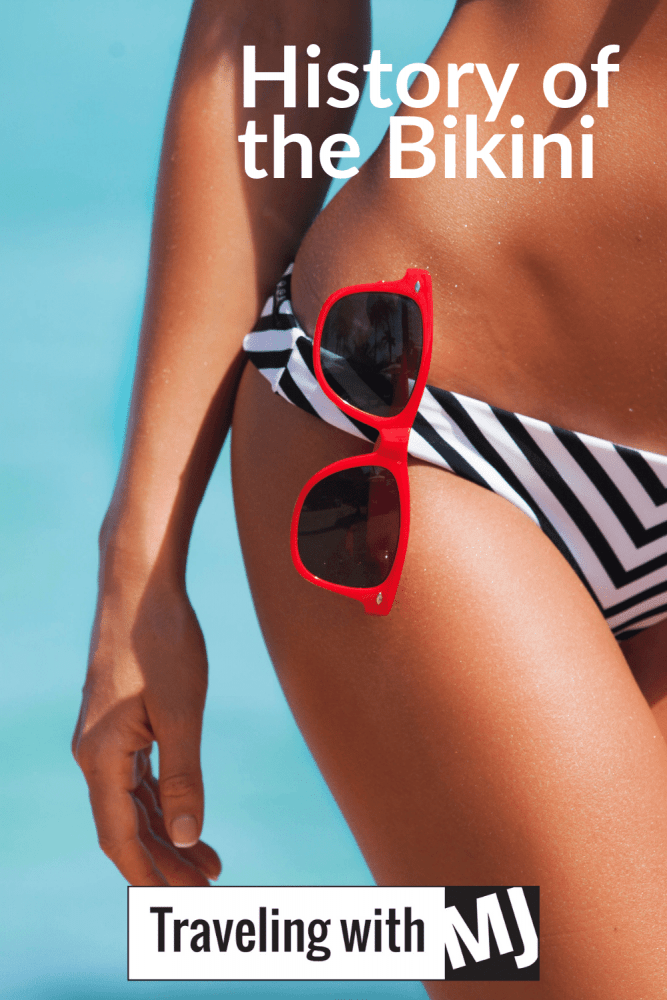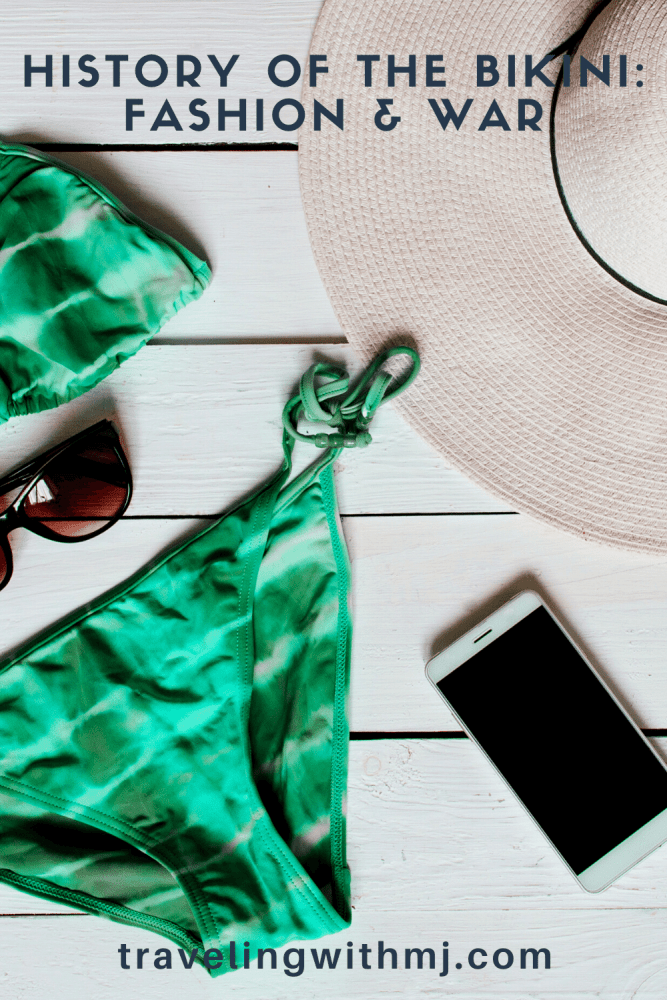For many women, the selection of the perfect bikini begins long before it’s time to hit the beach during vacation. It may very well be the first to-do item on a vacation preparation list. And for far too many women, there is no greater vacation angst than finding the right swimsuit – whether that’s a modern bikini, two-piece suit, or some other type of women’s swimwear. Learn about the history of the bikini.

History of the Modern Day Bikini
Archaeologists date the existence of a skimpy swimsuit back to 1600 BC., but the modern world was shocked by the debut of a new swimsuit made of mere inches of fabric. The bikini’s birthdate is considered to be July 5th, 1946.
Two competing French designers, Jacques Heim and Louis Reard, are credited with creating a new style of swimwear and changing the landscape of the public beaches forever. Heim selling the world’s smallest bathing suit at a beach shop in Cannes, France, and Reard created a swimsuit out of four small fabric triangles. When French designer Louis Reard unveiled the first bikini, it was a scandalous affair. Partly inspired by material rationing post World War II, the resulting swimsuit was scanty and risque for its day, and many people considered it indecent exposure. Micheline Bernardini, a French nude dancer, was the only person willing to showcase the swimwear to the public the first time.
Both designs and designers were successful, but Reard’s name for his design – after the Bikini Atoll, the atomic bomb testing site near Bikini Reef in the South Pacific – was what stuck. He named the two-piece swimsuit the bikini four days after Americans had tested the first nuclear weapon at the Bikini Atoll. Just as the testing was controversial, the bikini exploded on the fashion scene with a bang and its own controversy.
Bikini Atoll has since become a tourist site. In 2010, it was named a World Heritage Site for its role in history as a nuclear testing site. The skimpy two-piece has had a bit more of a bumpy road.
The Bikini is Banned
Despite the bikini’s popularity, the iconic swimsuit has courted controversy where ever it went.
Eric Morley organized the first Miss World contest in 1951. Originally, it was a bikini contest, part of the Festival of Britain. The swimsuit competition was specifically designed to promote the bikini and French fashion and design. Kiki Hakansson, a Swede, emerged as the winner of the beauty pageant and was crowned while wearing a bikini. A flurry of protests from participating countries, including Italy, Belgium, and Spain, followed. The Pope weighed in and condemned the crowning of the winner in a bikini. As a result, several countries with a Catholic majority took the cue and banned the swimwear that same year. Although the Miss World competition continues, the swimsuit competition was replaced with a more modest option, eventually being eliminated and replaced by the evening gown competition.
Interestingly, by today’s standards, the original style of bikini was quite modest. It’s certainly no longer the smallest swimsuit on the beach. With bikini bottoms cut well above the belly button and tops covering the full bust, it isn’t a skimpy suit at all. The 1970s saw the introduction of the smaller string bikini, and the 1980s introduced the even smaller thong. Since then, we’ve had the bankini, halter bikini, monokini, tankini, and even the mankini. Fashion always changes and today you’ll see American women of all body types wearing a bikini – it’s no longer reserved from thin fashion models vacationing on the French Riviera.
Interesting Facts About the Bikini
Here are a few fun facts about bikini history.
- 1960 – The release of the popular song “Itsy Bitsy Teenie Weenie Yellow Polka Dot Bikini“ cemented the bikini swimsuit as a pop culture icon.
- 1964 – Babette March wore a bikini on the cover of the first Sports Illustrated Swimsuit Issue. Other models and Hollywood stars would follow on subsequent covers.
- 1983 – Carrie Fisher, as Princess Leia in Return of the Jedi, sported the now famous gold bikini
- 1993 – The Olympic Committee officially recognized beach volleyball as an Olympic sport, and the United States beach volleyball team adopts the bikini as its uniform for its female athletes. Watching today, you’ll see a lot of bikinis. It’s almost like a beach party.
- 2002 – The sexy belted white bikini of Ursula Andress fame (from the James Bond movie Dr. No) is replicated for another Bond girl, Halle Berry in Die Another Day.
Visiting Bikini Atoll
Bikini Atoll intrigues tourists with its authentic history of the first atomic bomb test. The atoll is remote and sits on the northern side of the Ralik Chain, some 500 miles to the northwest of Majuro, the capital of the Marshall archipelago. It is one of 29 atolls and five islands located in the Marshall Islands, about halfway between Hawaii and Australia.
Once rocked by a series of massive atomic-and-hydrogen-bomb blasts, the atoll is now home to tranquil sandy beaches and picturesque turquoise lagoons. The waters have rich coral reefs and a wide variety of rare fish. The Marshall Islands are home to a large shark sanctuary, creating another attraction for divers.
Diving is one of the primary reasons for visiting Bikini Atoll and its world-class diving has created an economic revenue stream. The waters around Bikini Atoll in the Marshall Islands are clear all-year-round allowing visitors to explore the sea depths. Dozens of sunken ships, an aircraft carrier, a B-52 bomber that’s almost intact, and more war artillery dot the waters. In addition to obliterating three islands from the landscape, the bombing also created an enormous Bravo crater with a diameter of 6,510 feet and 250 feet in depth.
History loves may be interested in learning more about the sites where the nuclear testing was done. If the history angle is important, choose a dive tour operator that specializes in this area and can add value to your experience.
Bikini Atoll is not habitable, although marine life seems to flourish and diving is safe. There are no hotels. Visitors arrive by vessels. Advanced permission is required, and there are requirements for a guide and government official to accompany visitors. There are few public facilities on the island, but bathroom and shower facilities are available. The revenue raised from the various dive programs supports efforts to eventually return Bikini-natives to their island.
How to Get to Bikini Atoll
Marshall Islands International Airport (airport code MAJ), also known as Amata Kabua International Airport, is the largest airport in the Marshall Islands. From the U.S., you’d fly from Honolulu (airport code HNL) on United Airlines, currently the only international airline flying the route. The flight I approximately 4:45 in duration.
Once in Amata Kubua, you’ll need to hire an authorized vessel for the rest of the trip. There is currently no airline service to Bikini Atoll.
Happy Birthday Bikini
Today, I can’t imagine a beach that isn’t covered with bikini-clad women and girls. It has become a de rigueur fashion statement and a billion-dollar fashion business. And while I would like to see fewer bikini-clad young white women in advertising, Instagram photos, and various marketing campaigns, there’s no getting around the fact that this fashion statement is here to stay.
Whether you’re a bikini wearer or not, and I’m not, let’s all celebrate this fashion birthday by heading to our favorite beach.
Save to your favorite Pinterest boards


